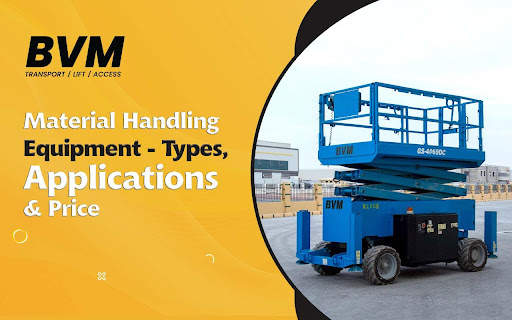
Material Handling Equipment – Types, Applications & Price
In industrial and commercial settings, efficient material handling is crucial for streamlining operations, minimizing downtime, and ensuring worker safety.
With a wide range of material handling equipment available, businesses can optimize their processes and improve productivity.
This comprehensive guide will explore the various types of material handling equipment, their applications, and pricing considerations.
Types of Material Handling Equipment:
1. Forklifts:
Forklifts are among the most versatile and widely used material-handling equipment.
They come in various types, including counterbalance forklifts, reach trucks, and side loaders. Counterbalance forklifts are suitable for lifting and transporting heavy pallets, while reach trucks excel in narrow aisles and high-reach applications.
Container Side loaders are designed for handling long, bulky loads from the side, making them ideal for industries like lumber, steel, and concrete.
2. Pallet Jacks
Pallet jacks, also known as pallet trucks, are essential for moving palletized loads over short distances.
They are available in manual and powered versions, with the latter offering greater efficiency and reduced physical strain on operators.
3. Conveyors
Conveyors are material handling systems that transport goods continuously along a fixed path.
They come in various types, including belt conveyors, roller conveyors, and overhead conveyors.
Conveyors are commonly used in manufacturing plants, warehouses, and distribution centers for efficient product movement.
4. Cranes and Hoists
Cranes and hoists are heavy-duty material handling equipment for lifting and moving extremely heavy loads.
Overhead cranes, JIB cranes, and gantry cranes are commonly used in construction, manufacturing, and shipping industries.
5. Automated Storage and Retrieval Systems (AS/RS):
AS/RS are highly automated systems that efficiently store and retrieve goods in warehouses and distribution centres.
These systems utilize cranes, conveyors, and computerized controls to maximize space utilization and streamline inventory management.
6. Liquid Transport:
For businesses dealing with liquid materials, specialized equipment like tanker trucks, liquid transfer pumps, and hose reels are essential.
Liquid transport services provide safe and efficient transportation and handling of various liquids, including chemicals, fuels, and industrial fluids.
Applications of Material Handling Equipment:
Material handling equipment finds applications across numerous industries, including:
Manufacturing:
Forklifts, conveyors, and cranes are widely used in manufacturing facilities for moving raw materials, work-in-progress items, and finished goods.
Warehousing and Distribution:
Pallet jacks, forklifts, and AS/RS are crucial in warehouses and distribution centers for efficient storage, retrieval, and transportation of goods.
Construction:
Cranes, hoists, and forklifts are indispensable on construction sites for lifting and moving heavy materials, equipment, and prefabricated components.
Retail and Logistics:
Conveyors, pallet jacks, and forklifts streamline operations in retail stores, distribution centers, and logistics hubs, ensuring the efficient movement of goods.
Agriculture and Food Processing:
Specialized material handling equipment, such as grain augers, feed conveyors, and liquid transport services, are essential in the agriculture and food processing industries.
Chemical and Pharmaceutical Industries:
Liquid transport services, including tanker trucks and pumps, are critical for safely handling and transporting various chemicals and pharmaceutical products.
Pricing Considerations for Material Handling Equipments
The cost of material handling equipment can vary significantly depending on several factors:
- Equipment Type: Larger, more complex equipment like cranes and AS/RS tend to be more expensive than simpler equipment like pallet jacks and conveyors.
- Capacity and Features: Higher load capacities, advanced features, and specialized configurations generally result in higher prices.
- New vs. Used: While new equipment offers the latest technology and full warranties, used equipment can be a cost-effective option for businesses on a budget.
- Purchase vs. Rental: Some businesses may choose to rent material handling equipment for short-term or seasonal needs, potentially offering cost savings compared to outright purchases.
- Maintenance and Operating Costs: Besides the initial purchase price, businesses should consider ongoing maintenance, repair, and operational costs, such as fuel or electricity consumption.
To give a rough idea of pricing, a basic manual pallet jack can cost between $300 and $1,000, while a new counterbalance forklift can range from $20,000 to $50,000 or more, depending on its capacity and features.
Larger equipment like cranes and AS/RS can cost hundreds of thousands or even millions of dollars, depending on the complexity and scale of the system.
Conclusion:
Choosing the right material handling equipment is crucial for optimizing operations, improving efficiency, and ensuring worker safety. Businesses should carefully evaluate their specific needs, budget, and future growth plans when selecting the appropriate equipment.
Consulting with experienced material-handling equipment providers can help businesses make informed decisions and maximize their return on investment.



